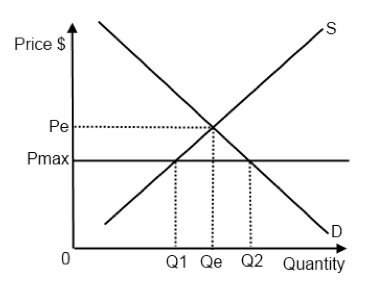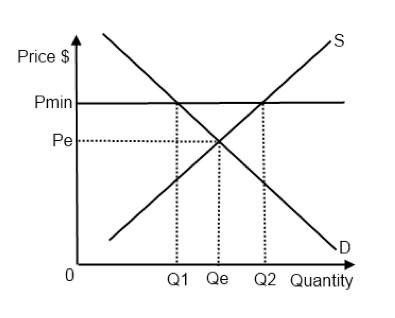Price controls
Price ceilings (maximum prices): rationale, consequences and examples
Price ceilings (maximum prices): is a situation where government sets a maximum price, below the equilibrium price to prevent producers from raising the price above it.
- Set to protect consumers
- Usually in markets of necessity or merit goods (good that would be underprovided if the market were allowed to operate freely)
- I.e. Maximum food price controls during food shortage?ensure low-cost food for the poor.
- I.e. Maximum rent controls?ensure affordable accommodation for those on low incomes.

Figure 3.12 - A price ceilling
- If maximum price is imposed at Pmax, Q2 will be demanded because price has fallen, but only Q1 will be supplied. ?excess demand
- Eventually consumption will fall from Qe to Q1, even though it is at a lower price
- Consumer expenditure (firm’s revenue) will decrease
Consequences of maximum price:
- Shortages: leads to forming of black market/underground parallel market (where product is sold at a higher price, somewhere between Pe and Pmax.)
- Non-price rationing mechanisms: Long queues or reservations → can determine the order in which consumers are served.
- Welfare impacts: Producer surplus decreases, consumer surplus increase
- Inefficient resource allocation: allocatively inefficient
Impacts on stakeholders:
- Consumers: lower prices, but have to go through non-price rationing mechanisms
- Producers: lower selling price → revenue decreases
- Government: increase spending on solving the consequences → subsidize or direct provision to shift the supply curve to right → reduce government expenditure in other areas → opportunity cost
Price floors (minimum prices): rationale, consequences and examples
Price floors (minimum prices): is a situation where the government sets a minimum price, above the equilibrium price to prevent producers from reducing the price below it.
- Set to protect producers of goods & services that government thinks are important. i.e. agricultural products
- To protect workers by setting minimum wage → ensure workers earn enough to lead a reasonable existence

Figure 3.13 - A price floor
- If minimum price is imposed at Pmin, only Q1 will be demanded since the price has risen, but Q2 will now be supplied. → excess supply
- Consumption will fall from Qe to Q1
- Consumer expenditure (firm’s revenue) will decrease.
Consequences of minimum price:
- Surpluses: producer will be tempted to get around the price controls and sell their excess supply for a lower price, somewhere between Pmin & Pe.
- Disposal of the surplus by the government
- Welfare impact: producer surplus increases, consumer surplus decreases
- Inefficient resource allocation: allocatively inefficient
Impacts on stakeholders:
- Consumers: higher prices
- Producer: higher selling price → less cost-conscious → inefficiency & waste of resources OR producing more of protected product than other products that they could produce more efficiently
- Government: increase spending on solving the consequences → store, destroy or selling the surplus abroad (dumping → harm other domestic industries → angry reaction from foreign governments) OR increase demand by advertising or restricting supplies of imports through protectionist policies (thus increase demand for domestic products)
